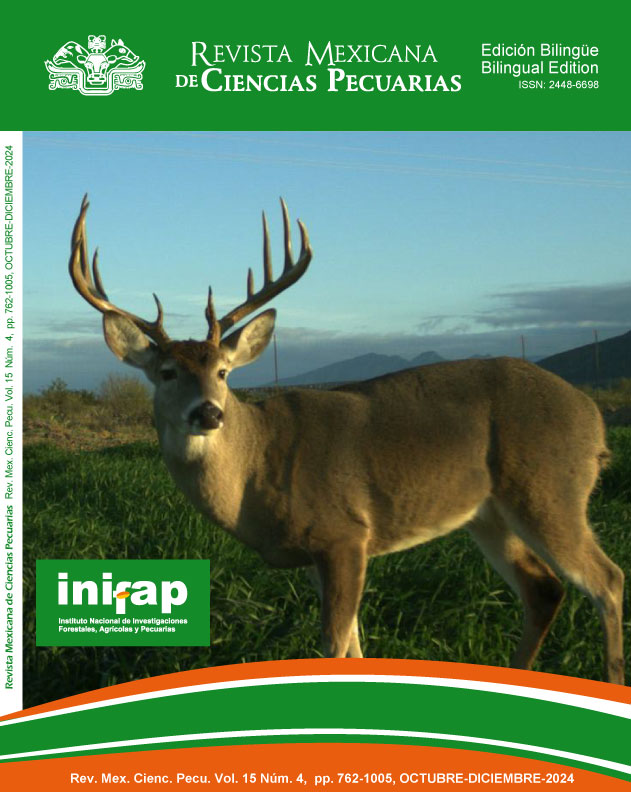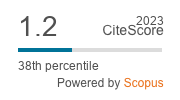Evaluación in vitro de una fuente de nitrato protegido para rumiantes: efecto sobre la degradación de la materia seca y producción de metano
DOI:
https://doi.org/10.22319/rmcp.v15i4.6402Palabras clave:
Aditivos, Metano, Nitrato encapsuladoResumen
El objetivo fue evaluar un método para reducir la tasa de liberación del nitrato de calcio en un ambiente de fermentación ruminal simulado, y determinar su efecto sobre sobre la degradación de la materia seca y la producción de metano. En el experimento in vitro se usó pasto kikuyo (Cenchrus clandestinus, Hochst ex Chiov) (KK) como alimento base y la adición de nitrato protegido (NP), nitrato libre (NL) y urea (KU) al ambiente de fermentación. La cantidad de nitrato adicionado correspondió al 3 % de la materia seca incubada. Los datos se analizaron con medidas repetidas en el tiempo considerando como efectos fijos el tratamiento y el tiempo y como factor aleatorio el animal donador del inóculo ruminal. Después de 24 h de incubación, el NL y el NP redujeron la degradación de la materia seca en 11.4 y 15 %, respectivamente. La adición de nitratos redujo significativamente la producción de metano. La diferencia en las tasas de producción de metano expresadas en ml/g de materia seca degradada entre los tratamientos NL (21.0) y NP (31.2) a las 48 h de incubación, indican menor tasa de liberación del nitrato como consecuencia del método de protección empleado. Los resultados de este ensayo muestran que la inclusión de nitratos protegidos en niveles correspondientes al 3 % de la materia seca incubada pueden llegar a reducir en un 53 % la producción de metano.
Descargas
Citas
IPCC. Climate Change 2013: The physical science basis. Inter-governmental Panel on Climate Change, Working Group I Contribution to the IPCC Fith Assessment Report. Cambridge Univ Press, New York, USA. 2013. https://www.ipcc.ch/pdf/assessmentreport/ar5/wg1/WG1AR5_ALL_FINAL.pdf.
FAO. Organización de las Naciones Unidas para la Alimentación y la Agricultura. Soluciones ganaderas para el cambio climático. 2018. https://openknowledge.fao.org/server/api/core/bitstreams/4c38936f-8175-4752-bb66-32710168079e/content.
Lee C, Beauchemin KA. A review of feeding supplementary nitrate to ruminant animals: nitrate toxicity, methane emissions, and production performance. Can J Anim Sci 2014;94(4):557-570. DOI: https://doi.org/10.4141/cjas-2014-069
Hino T, Asanuma N. Suppression of ruminal methanogenesis by decreasing the substrates available to methanogenic bacteria. CAB Reviews. Perspect Agric Vet Sci Nutr Nat Resour 2003;73:1R-8R. DOI: https://doi.org/10.1079/cabireviews20033023935
Ungerfeld EM, Kohn RA. The role of thermodynamics in the control of ruminal fermentation. Ruminant Physiol 2006;55–85. DOI: https://doi.org/10.3920/9789086865666_003
Bruning-Fann CS, Kaneene JB. The effects of nitrate, nitrite, and N-nitroso compounds on animal health. Vet Hum Toxicol 1993;35(3):237–253.
Lee C, Araujo RC, Koenig KM, Beauchemin KA. Effects of encapsulated nitrate on enteric methane production and nitrogen and energy utilization in beef heifers. J Anim Sci 2015;93(5):2391–2404. DOI: https://doi.org/10.2527/jas.2014-8845
Lee C, Araujo R, Koenig KM, Beauchemin KA. In situ and in vitro evaluations of a slow-release form of nitrate for ruminants: Nitrate release rate, rumen nitrate metabolism and the production of methane, hydrogen, and nitrous oxide. Anim Feed Sci Technol 2017;231:97-106. DOI: https://doi.org/10.1016/j.anifeedsci.2017.07.005
Mamvura CI, Cho S, Mbiriri DT, Lee HG, Choi NJ. Effect of encapsulating nitrate in sesame gum on in vitro rumen fermentation parameters. J Anim Sci 2014;27(11):1577–1583. DOI: https://doi.org/10.5713/ajas.2014.14280
AOAC. Official Methods of Analysis. 18th ed. Washington, DC, USA: Association of Official Analytical Chemists. 2005.
Castillo C, Hernández J. Ruminal fistulation and cannulation: A necessary procedure for the advancement of biotechnological research in ruminants. J Anim 2021;11(7):1870. DOI: https://doi.org/10.3390/ani11071870
McDougall EI. Studies on ruminant saliva. 1. The composition and output of sheep's saliva. Biochem J 1948;43(1):99–109. DOI: https://doi.org/10.1042/bj0430099
Posada SL, Rosero-Noguera R, Bolívar D. Relación entre presión y volumen para la implementación de la técnica in vitro de producción de gases en Medellín, Colombia. Rev Colomb Cienc Pecu 2006;19(4):407-414. DOI: https://doi.org/10.17533/udea.rccp.324098
Posada SL, Ramírez-Agudelo JF, Rosero-Noguera R. Producción de metano y digestibilidad de mezclas kikuyo (Pennisetum clandestinum) - papa (Solanum tuberosum). Rev Agron Mesoam 2014;25(1):141-150. DOI: https://doi.org/10.15517/am.v25i1.14214
SAS Inst. Inc. 2019. http://www.sas.com/en_us/software/university-edition.html.
Sukhija PS, Palmquist DL. Dissociation of calcium soaps of long-chain fatty acids in rumen fluid. J Dairy Sci 1990;73(7):1784–1787. DOI: https://doi.org/10.3168/jds.S0022-0302(90)78858-3
Jenkins TC, Palmquist DL. Effect of added fat and calcium on in vitro formation of insoluble fatty acid soaps and cell wall digestibility. J Anim Sci 1982;55(4):957–963. DOI: https://doi.org/10.2527/jas1982.554957x
Natel AS, Abdalla AL, de Araujo RC, McManus C, Paim T, de Abdalla FAL, et al. Encapsulated nitrate replacing soybean meal changes in vitro ruminal fermentation and methane production in diets differing in concentrate to forage ratio. J Anim Sci 2019;90(10):1350–1361. DOI: https://doi.org/10.1111/asj.13251
Zhao L, Meng Q, Li Y, Wu H, Huo Y, Zhang X, Zhou Z. Nitrate decreases ruminal methane production with slight changes to ruminal methanogen composition of nitrate-adapted steers. BMC Microbiol 2018;18:21. DOI: https://doi.org/10.1186/s12866-018-1164-1
Zhou Z, Yu Z, Meng Q. Effects of nitrate on methane production, fermentation, and microbial populations in in vitro ruminal cultures. Bioresour Technol 2012;103(1):173–179. DOI: https://doi.org/10.1016/j.biortech.2011.10.013
Hulshof RB, Berndt A, Gerrits WJ, Dijkstra J, van Zijderveld SM, Newbold JR, Perdok HB. Dietary nitrate supplementation reduces methane emission in beef cattle fed sugarcane-based diets. J Anim Sci 2012;90(7):2317–2323. DOI: https://doi.org/10.2527/jas.2011-4209
Leng R. Interactions between microbial consortia in biofilms: A paradigm shift in rumen microbial ecology and enteric methane mitigation. Anim Pros Sci 2014;54:519-543. DOI: https://doi.org/10.1071/AN13381
Zhou Z, Meng Q, Yu Z. Effects of methanogenic inhibitors on methane production and abundances of methanogens and cellulolytic bacteria in in vitro ruminal cultures. Appl Environ Microbiol 2011;77(8): 2634–2639. DOI: https://doi.org/10.1128/AEM.02779-10
Lin M, Schaefer DM, Zhao GQ, Meng QX. Effects of nitrate adaptation by rumen inocula donors and substrate fiber proportion on in vitro nitrate disappearance, methanogenesis, and rumen fermentation acid. J Anim 2013;7(7):1099–1105. DOI: https://doi.org/10.1017/S1751731113000116
Patra A, Yu Z. Effects of adaptation of in vitro rumen culture to garlic oil, nitrate, and saponin and their combinations on methanogenesis, fermentation, and abundances and diversity of microbial populations. Front Microbiol 2015;6:1434. DOI: https://doi.org/10.3389/fmicb.2015.01434
Wang M, Wang R, Yang S, Deng JP, Tang SX, Tan ZL. Effects of three methane mitigation agents on parameters of kinetics of total and hydrogen gas production, ruminal fermentation and hydrogen balance using in vitro technique. J Anim Sci 2016;87(2):224-232. DOI: https://doi.org/10.1111/asj.12423
Machmueller A. Medium-chain fatty acids and their potential to reduce methanogenesis in domestic ruminants. Agric Ecosyst Environ 2006;112(2):107-114. DOI: https://doi.org/10.1016/j.agee.2005.08.010
Zumft WG. The biological role of nitric oxide in bacteria. Arch Microbiol 1993;160(4):253–264. DOI: https://doi.org/10.1007/BF00292074
van Zijderveld SM, Gerrits WJ, Apajalahti JA, Newbold JR, Dijkstra J, Leng RA, Perdok, HB. Nitrate and sulfate: Effective alternative hydrogen sinks for mitigation of ruminal methane production in sheep. J Dairy Sci 2010;93(12):5856–5866. DOI: https://doi.org/10.3168/jds.2010-3281
Lund P, Dahl R, Yang H, Hellwing A, Cao B, Weisbjerg M. The acute effect of addition of nitrate on in vitro and in vivo methane emission in dairy cows. Anim Prod Sci 2014;54(9):1432-1435. DOI: https://doi.org/10.1071/AN14339
Leng R, Emeritus D. The potential of feeding nitrate to reduce enteric methane production in ruminants. A report to the department of climate change, Canberra, Australia. 2008.
Kaspar HF, Tiedje JM. Dissimilatory reduction of nitrate and nitrite in the bovine rumen: nitrous oxide production and effect of acetylene. Appl Environ Microbiol 1981;41(3):705-709. DOI: https://doi.org/10.1128/aem.41.3.705-709.1981
Welty CM, Wenner BA, Wagner BK, Roman-Garcia Y, Plank JE, Meller RA, et al. Rumen microbial responses to supplemental nitrate. II. Potential interactions with live yeast culture on the prokaryotic community and methanogenesis in continuous culture. J Dairy Sci 2019;102(3):2217–2231. DOI: https://doi.org/10.3168/jds.2018-15826
Descargas
Publicado
Cómo citar
-
Resumen239
-
PDF119
-
PDF 24
-
Texto completo16
-
Full text 13
Número
Sección
Licencia

Esta obra está bajo una licencia internacional Creative Commons Atribución-NoComercial-CompartirIgual 4.0.
Los autores/as que publiquen en la Revista Mexicana de Ciencias Pecuarias aceptan las siguientes condiciones:
De acuerdo con la legislación de derechos de autor, la Revista Mexicana de Ciencias Pecuarias reconoce y respeta el derecho moral de los autores/as, así como la titularidad del derecho patrimonial, el cual será cedido a la revista para su difusión en acceso abierto.

Esta obra está bajo una Licencia Creative Commons Atribución-NoComercial-CompartirIgual 4.0 Internacional.





